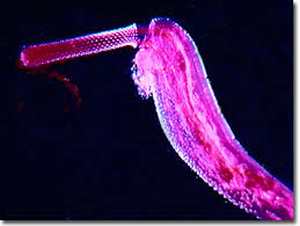

MedFriendly®


Acanthoid
Acanthoid means spine-shaped, thorn-shaped, or
prickly. In biology, one of the best examples of an
acanthoid species is Acanthocephala (see picture to
the right), which are a group of parasite worms with
thorny or spiny heads. A parasite is an organism that
lives in or on another organism to obtain nourishment.
Acanthocephala uses its spines to pierce the gut of
the host and hold on to it. For information on infections
caused by Acanthocephala, see the entry on
Acanthocephala
FEATURED BOOK: Parasite Rex: Bizarre World of Nature's Most Dangerous
Other animals with acanthoid features include chitons (type of mollusk), sea urchins, sea
cucumbers, porcupines, anteaters, lobsters, and crabs. The spiny and thorny features
provide as much needed defense mechanisms. The thorny bodily features make the skin
difficult to penetrate and can make useful weapons. Some cells have been described as
acanthoid shaped, such as red blood cells (which carry oxygen to the blood) and
astrocytes. Astrocytes are star shaped types of glial cells, which are cells that support
and maintain other cells. In botany (plant science) certain types of plants have acanthoid
features due to thorns or spiny processes. Acanthoid comes from the Greek word
“anthos” meaning “a thorn, spine” and the Greek word "eidos" meaning "resemblance."
Together the words mean "a spine resemblance.
"Where Medical Information is Easy to Understand"™
















